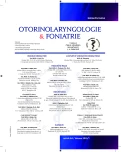Modified Calculation of Average Active Drain Output Allows their Earlier Removal in Head and Neck Surgery
Authors:
Richard Salzman; M. Brož; I. Stárek
Authors‘ workplace:
Otolaryngologická klinika FN Olomouc, Lékařská fakulta Univerzity Palackého v Olomouci, přednosta prof. MUDr. I. Stárek, CSc.
Published in:
Otorinolaryngol Foniatr, 64, 2015, No. 1, pp. 22-27.
Category:
Original Article
Overview
Introduction:
Drains with active suction are routinely used in head and neck surgery in order to decrease risk of postoperative complications. Majority of surgeons remove drains when the average drain output drops under 1 mL/hour. Significantly higher output during the first postoperative hours skews their computation. Therefore, we didn’t include the first postoperative hours in this calculation. We rather started at 6pm of the day of surgery. The aim of the study was to determine if the alteration of the way the average output to drains is calculated, will allow their earlier removal.
Methods:
In the prospective randomized study, 36 patients (38 surgeries with postoperative active drainage) were included in February 2013 to May 2041. All surgeries were performed by 2 experienced head and neck surgeons
The average drain output was calculated from 6 pm of the day of surgery till 6am of the following morning in seventeen patients after 18 surgeries (group A). Subsequent estimations were done always at 6am, and again and again after 24 hours.
In nineteen patients (group B) having 20 surgeries, the average drain output was computed traditionally, i.e. from the drain insertion at the end of surgery till 6am following morning. Later calculations were performed identically to group A.
Using statistical methods, we compared the time from the end of surgery to drain removal.
Results:
In group A, drains were removed on day 1 in 55.6 % cases. The remaining drains were removedon day 2. In group B, the very first drains were extracted on day 2 (in 72.2 % of patients). Remainders of drains were removed between day 3 and 4. The comparison of results between the groups was statistically significant.
Conclusion:
Minor alteration in the calculation of average drain output allows their earlier and still safe removal.
Keywords:
active suction drain, bleeding, drain, drainage, haematoma, neck dissection, length of hospitalization, surgery
Sources
1. Abboud, B., Tannoury, J., Sleilaty, G., Daher, R., Abad-jian, G., Ghorra, C.: Cervical neck dissection without drainage in papillary thyroid carcinoma. J. Laryngol. Otol,, 127, 2013, 3, s. 299-302.
2. Amir, I., Morar, P., Belloso, A.: Postoperative drainage in head and neck surgery. Ann. R. Coll. Surg. Engl., 92, 2010, s. 651-654.
3. Batstone, M. D., Lowe, D., Shaw, R. J., Brown, J. S., Vaughan, E. D, Rogers, S. N.: Passive versus active drainage following neck dissection: a non-randomised prospective study. Eur. Arch. Otorhinolaryngol., 266, 2009, s. 121-124.
4. Brown, B. M., Johnson, J. T., Wagner, R. L.: Etiologic factors in head and neck wound infections. Laryngoscope, 97, 1987, 5, s. 587-590.
5. Cobb, J. P.: Why use drains. J. Bone Joint Surg., 72B, 1990, s. 993-995.
6. Conger, B. T., Gourin, C. G.: Free abdominal fat transfer for reconstruction of the total parotidectomy defect. Laryngoscope, 118, 2008, s. 1191-1194.
7. Durai, R., Ng, P. C.: Surgical vacuum drains: types, uses, and complications. AORN J 91, 2010, s. 266-271.
8. Lee, S. W., Choi, E. C., Lee, Y. M., Lee, J. Y., Kim, S. C.,Koh, Y. W.: Is lack of placement of drains after thyroidectomy with central neck dissection safe? A prospective, randomized study. Laryngoscope, 116, 2006, s. 1632-1635.
9. Minami, S., Sakimura, C., Hayashida, N., Yamanouchi, K., Kuroki, T., Eguchi, S.: Timing of drainage tube removal after thyroid surgery: a retrospective study. Surg. Today, 44, 2014, s. 137-141.
10. Mofle, P. J., Urquhart, A. C.: Superficial parotidectomy postoperative drainage. J. Clin. Med. Res., 6, 2008, 2, s. 68-71.
11. Parker, M. J., Livingstone, V., Clifton, R., McKee, A.: Closed suction surgical wound drainage after orthopaedic surgery (Review). Cochrane Database Syst. Rev., 3, 2007, CD001825.
12. Rodgers, G. K., Johnson, J. T., Petruzzelli, G., J., Warty, V. S.,Wagner, R., L.: Lipid and volume analysis of neck drainage in patients undergoing neck dissection. Am. J. Otol., 13, 1992, s. 306-309.
13. Salami, A., Dellepiane, M., Bavazzano, M., Crippa, B., Mora, F., Mora, R.: New trends in head and neck surgery: A prospective evaluation of the harmonic scalpel. Med. Sci. Monit., 14, 2008, 5, s. 1-5.
14. Shaha, A. R., Jaffe, B. N.: Selective use of drains in thyroid surgery. J. Surg. Oncol., 52, 1993, s. 41-43.
15. Tabaqchali, l., Hanson, J., Proud, G.: Drains for thyroidectomy/parathyroidectomy: fact or fiction? Ann. R. Coll. Surg. Engl., 81, 1999, s. 302-305.
16. Urquhart, A. C., Berg, R. L.: Neck dissections: predicting postoperative drainage. Laryngoscope, 112, 2002, 1294-1298.
17. Williams, J., Toews, D., Prince, M.: Survey of the use of suction drains in head and neck surgery and analysis of their biomechanical properties. J. Otol., 32, 2003, 1, s. 16-22.
18. Willy, C., Sterk, J., Gengross, H., Schmidt, R.: Drainage in soft tissue surgery. What is ‚evidence based‘? Chirurg, 74, 2003, s. 108-114.
19. Woods, R. S. R., Woods, J. F. C., Duignan, E. S., Timon, C.: Systematic review and meta-analysis of wound drains after thyroid surgery, BJS, 101, 2014, s. 446-456.
20. Yoo, J., Roth, K., Hughes, B., Fung, K., Franklin, J., Lam-pe, H., Pietrzak, W. S.: Evaluation of postoperative drainage with application oÍ platelet-rich and platelet-poor plasma following hemithyroidectomy: a randomized controlled trial. Head Neck, 30, 2OO8, s. 1552-1558.
Labels
Audiology Paediatric ENT ENT (Otorhinolaryngology)Article was published in
Otorhinolaryngology and Phoniatrics

2015 Issue 1
Most read in this issue
- Relevance of Measurement of Nasal Nitric Oxide as Bioindicator of Inflammation in Otorhinolaryngology
- Cogan's Syndrome
- First Experience with Inner Ear Imaging Using Magnetic Resonance after Intratympanic Application of Contrast Medium
- Diffuse Large B-cell Lymphoma as the Most Common Non-Hodgkin B-cell Lymphoma of the Head and Neck
